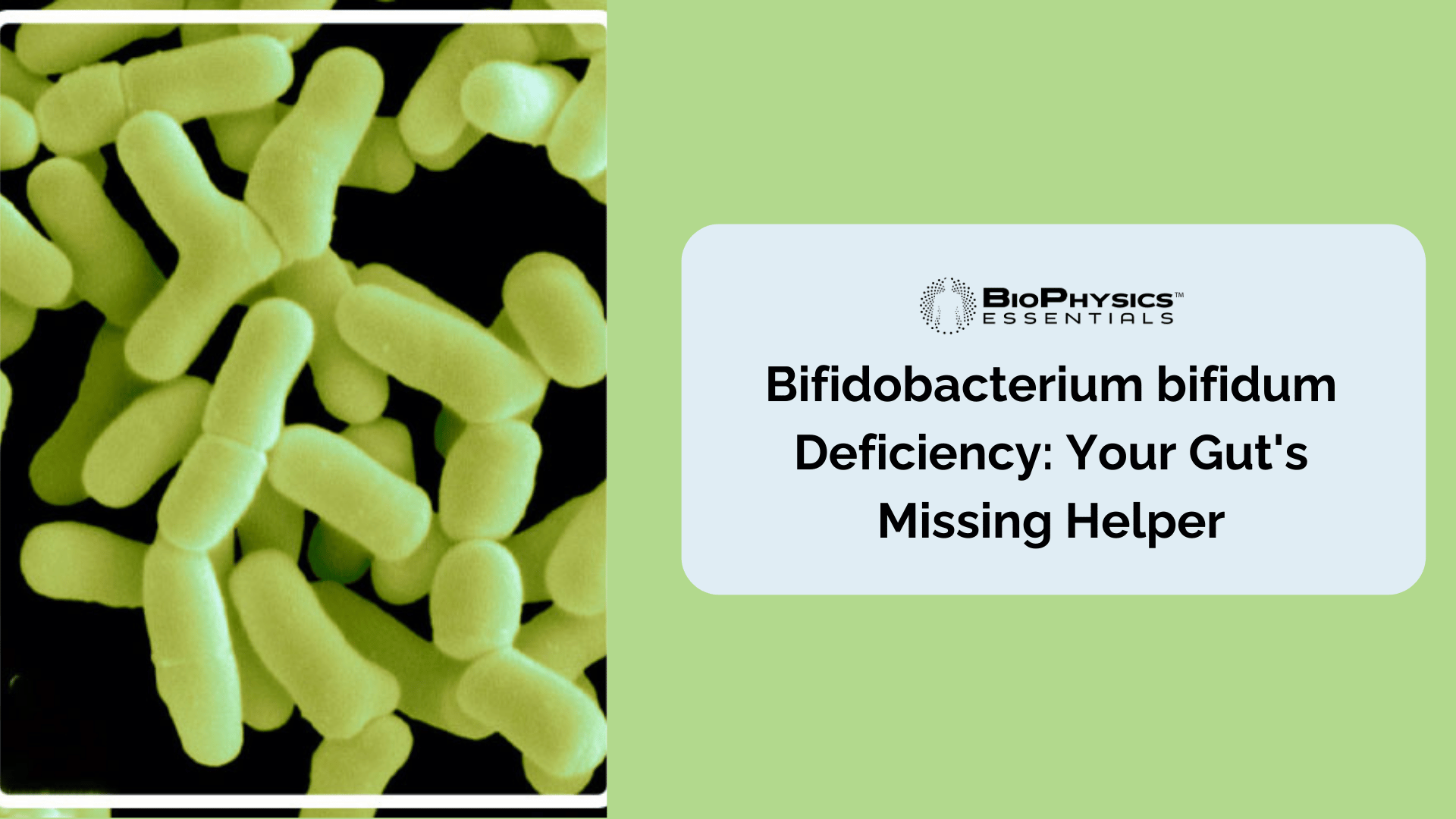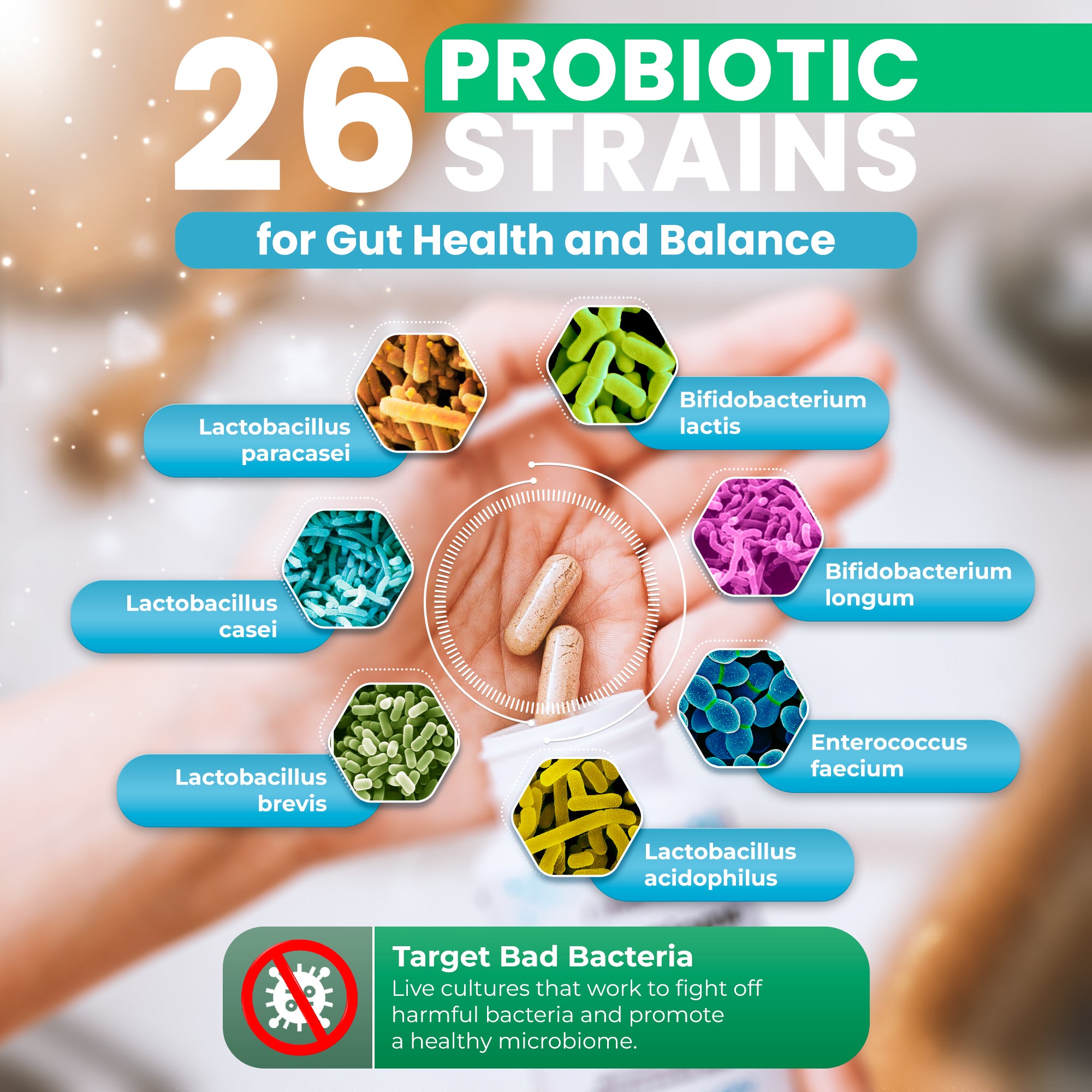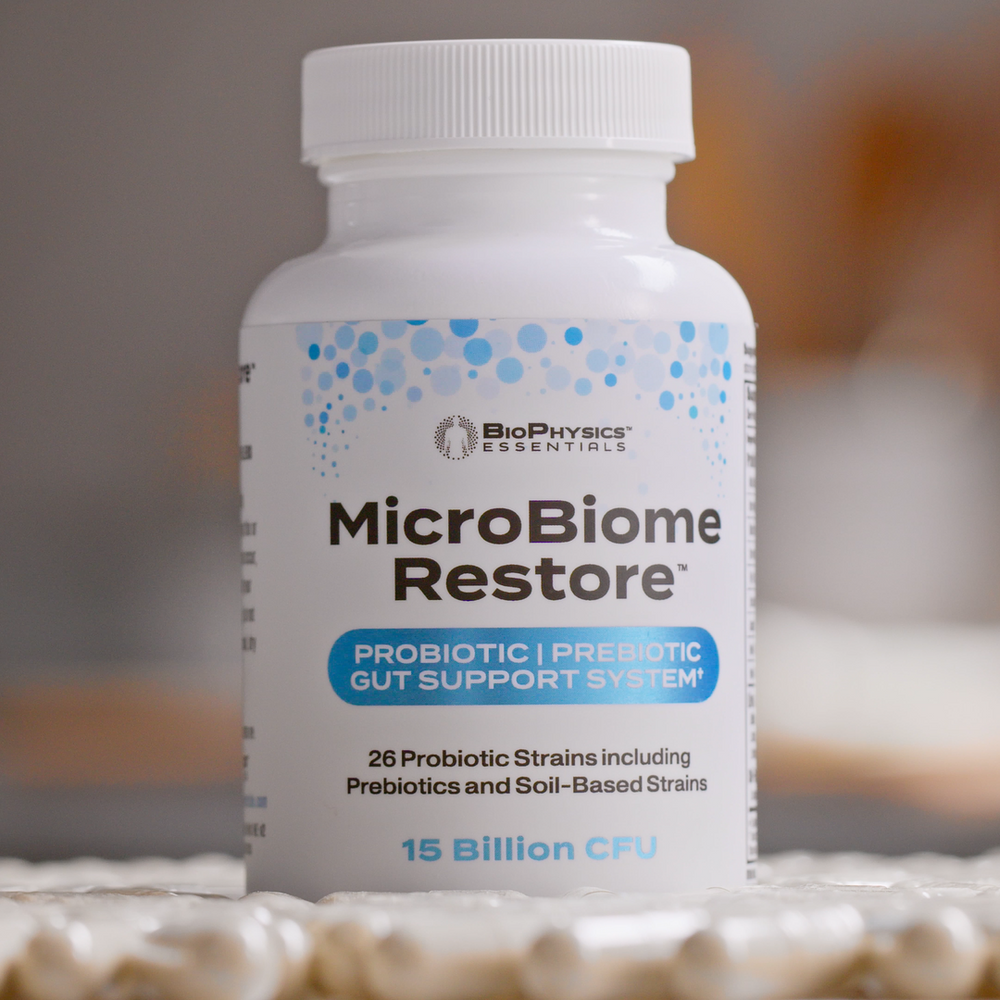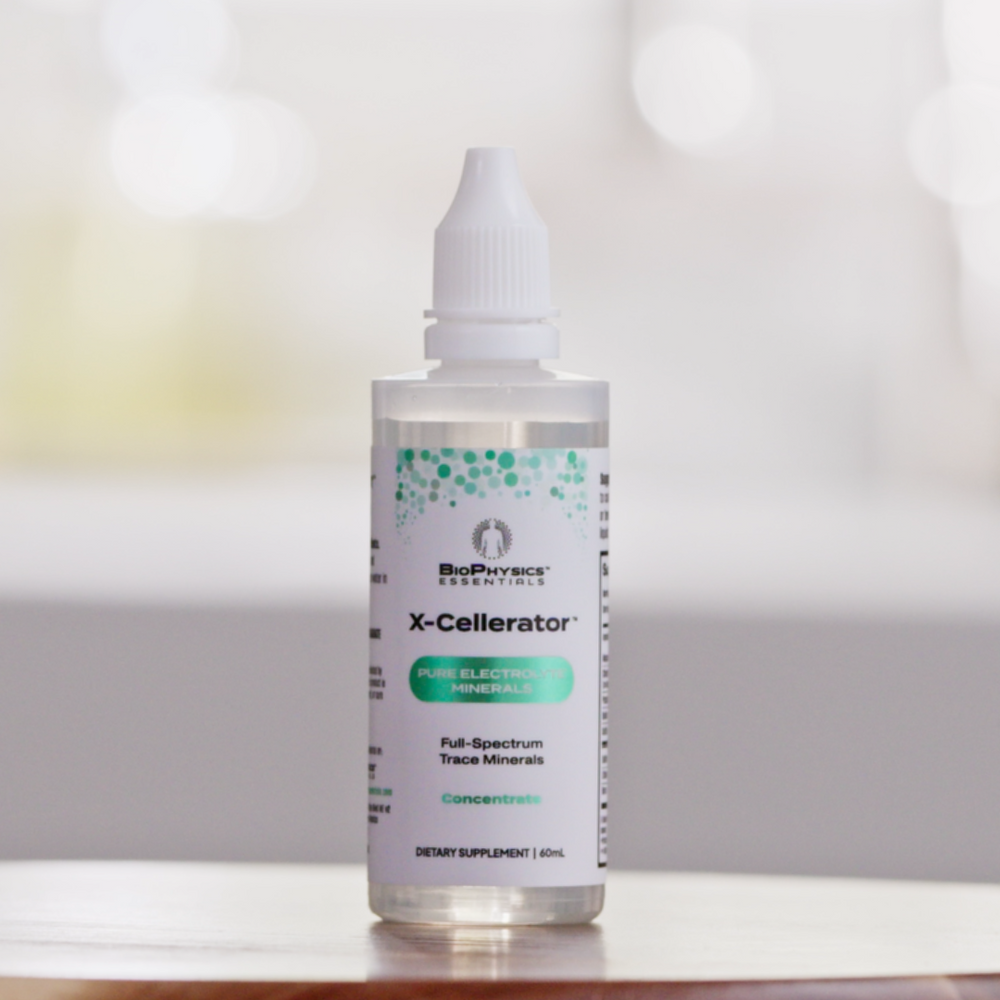How to Fix B. bifidum Deficiency: Science-Based Guide to Gut Health
Bifidobacterium bifidum is a beneficial bacteria that lives in your gut and plays a crucial role in maintaining your health from infancy through old age. As one of the pioneering colonizers of the human gut microbiome, this tiny helper supports digestion, strengthens the immune system, and protects against harmful bacteria. Unfortunately, many people don't have enough of it, which can lead to various health challenges. Let's explore why this small but mighty bacteria matters so much and how we can ensure it thrives in our digestive system.
| B. bifidum Deficiency: Key Points |
|---|
| - B. bifidum is crucial for infant gut health and immune development - B. bifidum levels naturally decrease with age - Deficiency can reduce overall gut microbiota diversity - Formula-fed babies have lower B. bifidum levels than breastfed infants - Antibiotic use can significantly lower B. bifidum populations - Lower B. bifidum in older adults weakens intestinal barriers - B. bifidum deficiency may increase inflammation throughout the body - Lack of B. bifidum can affect immune function and responses - Diet choices significantly impact B. bifidum levels - Probiotics and prebiotics can help maintain healthy B. bifidum levels |
Understanding Bifidobacterium bifidum: Your Gut's Friendly Helper
Bifidobacterium bifidum belongs to the genus Bifidobacterium within the phylum Actinobacteria, which represents one of the major phyla in the healthy human gut microbiota [1]. This gram-positive, non-spore-forming anaerobic bacterium is particularly abundant in breastfed infants, where it can constitute a significant portion of the total bacterial population [2].
What makes B. bifidum special among probiotic strains is its unique genetic and metabolic capabilities. This species possesses extracellular glycosidases that allow it to break down complex carbohydrates, particularly human milk oligosaccharides (HMOs) found in breast milk [3]. These special sugars pass through the infant's upper digestive tract undigested and serve as a primary food source for B. bifidum in the large intestine.
Beyond its role in carbohydrate metabolism, B. bifidum contributes to strengthening the intestinal barrier, producing antimicrobial compounds, and modulating immune responses [4]. This is why leading probiotic companies like BioPhysics Essentials include it in comprehensive formulations like MicroBiome Restore.
The Role of B. bifidum in Gut Microbiota Composition
The gut microbiota is a complex ecosystem containing trillions of microorganisms that work together to maintain our health. Within this community, Bifidobacterium species serve as keystone members, particularly during early life [5]. B. bifidum is one of the dominant Bifidobacterium species found in healthy breastfed infants, alongside B. breve and B. longum subspecies [6].
When we're born, our gut is rapidly colonized by microorganisms, with bifidobacteria among the first colonizers. B. bifidum is vertically transmitted from mother to infant during birth and supported through breastfeeding [2]. As we age, eat different foods, or take medications like antibiotics, the composition of our gut microbiome changes, often resulting in decreased levels of beneficial bifidobacteria.
The Impact of B. bifidum on Immune System Function
One of the most important roles of B. bifidum is its profound influence on immune system development and function. This probiotic strain has been extensively studied for its immunomodulatory properties, demonstrating the ability to influence both innate and adaptive immune processes [7].
Supporting Regulatory T Cells and Immune Balance
Research has identified specific components of B. bifidum that promote the generation of regulatory T cells (Tregs) in the intestine. Cell surface β-glucan/galactan polysaccharides from B. bifidum's cell wall have been shown to induce Foxp3+ regulatory T cells through interactions with dendritic cells [8]. These Tregs are crucial for maintaining immune tolerance and preventing excessive inflammatory responses.
In studies examining immune checkpoint blockade therapy, administration of Bifidobacterium species including B. bifidum was found to alter gut microbiota composition in a Treg-dependent manner, enhancing both the mitochondrial fitness and IL-10-mediated suppressive functions of intestinal Tregs [9]. This demonstrates how B. bifidum can help maintain the delicate balance between immune activation and regulation.
Producing Anti-inflammatory Compounds
B. bifidum contributes to immune function through multiple mechanisms beyond direct cellular interactions. Studies show that this strain can convert dietary vitamin A to retinoic acid through aldehyde dehydrogenases, which upregulates protective responses in intestinal epithelial cells and contributes to both immunological tolerance and adaptive immune responses [7].
Additionally, B. bifidum produces various bioactive factors that can reduce inflammation. Research on specific strains has demonstrated the ability to downregulate pro-inflammatory cytokines like TNF-α and IL-6 while upregulating anti-inflammatory markers [7]. This anti-inflammatory action is particularly relevant for managing chronic inflammatory conditions.
What Happens When We Don't Have Enough B. bifidum?
For Infants: Setting the Foundation for Lifelong Health
The infant gut microbiota plays a critical role in immune development, and B. bifidum is a key player in this process. A landmark study by Turroni and colleagues in 2012 revealed that babies who are formula-fed instead of breastfed, or who require antibiotic treatment, have significantly reduced levels of B. bifidum in their gut microbiome [10]. This reduction in bifidobacterial diversity can have several consequences.
First, lower B. bifidum levels mean fewer different types of beneficial bacteria overall, which may create opportunities for harmful bacteria to establish themselves more easily. Second, without adequate B. bifidum to break down human milk oligosaccharides, infants miss out on the production of beneficial short-chain fatty acids that support gut health and immune development.
Research has also shown that B. bifidum levels in infants influence the expression of tight junction proteins and the development of the intestinal barrier [11]. A compromised intestinal barrier in early life may contribute to increased risk of allergies, infections, and inflammatory conditions later in life.
For Adults: Digestive Health and IBS Management
In adults, B. bifidum deficiency has been particularly well-studied in relation to irritable bowel syndrome (IBS), a chronic gut-brain disorder affecting millions of people worldwide. Multiple clinical trials have demonstrated that B. bifidum supplementation can significantly improve IBS symptoms.
In a randomized, double-blind, placebo-controlled trial with 122 IBS patients, Bifidobacterium bifidum MIMBb75 significantly reduced global IBS symptom assessment, as well as specific symptoms including pain, discomfort, distension, bloating, urgency, and digestive disorders [12]. The probiotic group showed improvement of -0.88 points on a 7-point scale compared to only -0.16 points in the placebo group.
A larger multicenter trial involving 443 patients further confirmed these findings, with 34% of patients receiving heat-inactivated B. bifidum achieving at least 30% improvement in abdominal pain and adequate symptom relief, compared to only 19% in the placebo group [13]. Quality of life improvements were also significant.
The mechanisms behind these benefits likely involve B. bifidum's ability to strengthen tight junctions between intestinal cells, reduce gut permeability, and modulate the gut-brain axis [14]. Patients with IBS typically present with significantly lower levels of bifidobacteria in both fecal and duodenal mucosa samples, suggesting that restoring these beneficial bacteria may help rebalance the gut microbiota.
For Older Adults: Maintaining Gut Barrier Function
As we age, the composition and diversity of our gut microbiota changes significantly. Studies consistently show that Bifidobacterium levels, including B. bifidum, naturally decrease in elderly populations [15][6]. This age-related decline in bifidobacteria is associated with several health consequences.
A 2016 study by Arboleya and colleagues found that reduced Bifidobacterium levels in older adults correlate with weakened intestinal barrier function and increased systemic inflammation [15]. The intestinal barrier becomes more permeable with age, potentially allowing bacterial products and inflammatory compounds to enter the bloodstream more easily, contributing to chronic low-grade inflammation often seen in aging.
Research on elderly nursing home residents showed that those with diverse Bifidobacterium microbiota, including B. bifidum, B. longum, and B. adolescentis, had better immune parameters [16]. Negative correlations were observed between Bifidobacterium species levels and pro-inflammatory cytokine TNF-α, suggesting that maintaining adequate bifidobacteria may help control inflammation in older adults.
Interestingly, studies of centenarians have revealed unique gut microbiota compositions with specific Bifidobacterium profiles that may contribute to healthy aging and longevity [17]. While B. longum remains the predominant species across all age groups, the presence of various Bifidobacterium species throughout the lifespan appears important for maintaining gut health.
B. bifidum and Inflammatory Bowel Disease
Inflammatory bowel disease (IBD), including ulcerative colitis and Crohn's disease, represents chronic inflammatory conditions of the gastrointestinal tract. Research into the role of Bifidobacterium species, including B. bifidum, in IBD has yielded important insights, though the relationship is complex.
Protective Mechanisms in Experimental Models
Animal studies have demonstrated that B. bifidum can provide protective effects against experimental colitis. Research using dextran sulfate sodium (DSS)-induced colitis models showed that both treatment and pretreatment with B. bifidum ATCC 29521 significantly alleviated the severity of acute colitis [18]. The mechanisms include upregulation of tight junction proteins (ZO-1, MUC-2, Claudin-3) that strengthen the intestinal barrier, enhancement of anti-inflammatory pathways through increased IL-10 and PPARγ expression, downregulation of pro-inflammatory cytokines including TNF-α and IL-1β, and modulation of the gut microbiota composition to favor beneficial species [19].
Early life administration of B. bifidum has shown particular promise, with studies indicating that intervention during critical developmental windows may provide long-term protection against IBD development [20].
Important Considerations for Active Disease
While B. bifidum shows protective potential, research has revealed an important nuance: during active phases of IBD, Bifidobacterium and Lactobacillus levels are actually increased in intestinal biopsies compared to healthy controls [21]. This suggests these bacteria should be used more cautiously as probiotics during acute IBD flares, as the relationship between these bacteria and inflammation during active disease is not fully understood.
Clinical evidence for specific B. bifidum strains in IBD treatment remains limited compared to other probiotic formulations. The multi-strain probiotic VSL#3, which contains B. bifidum along with other bifidobacteria and lactic acid bacteria, has shown efficacy in maintaining remission of ulcerative colitis and pouchitis [22].
Factors Contributing to B. bifidum Deficiency
Multiple factors throughout life can contribute to reduced B. bifidum levels in the gut microbiota:
Antibiotic Use
Antibiotics are designed to kill bacteria, but they don't discriminate between harmful pathogens and beneficial gut bacteria. Studies consistently show that antibiotic exposure, particularly during infancy, significantly reduces Bifidobacterium populations including B. bifidum [10]. While the gut microbiota can often recover after antibiotic treatment, repeated or prolonged antibiotic courses may have lasting effects on microbial diversity.
Infant Feeding Methods
Breastfeeding supports B. bifidum colonization in multiple ways. Breast milk contains human milk oligosaccharides that specifically feed B. bifidum and related species [3]. Additionally, the bacteria are transmitted from mother to infant during breastfeeding. Formula-fed infants have lower B. bifidum levels and different overall gut microbiota composition, with higher levels of B. longum subsp. longum and B. adolescentis instead [6].
Dietary Factors
The modern Western diet, typically low in fiber and high in processed foods, does not support Bifidobacterium growth. B. bifidum and related species thrive on complex carbohydrates and dietary fibers that reach the colon undigested. Lack of these prebiotic fibers in the diet can lead to reduced bifidobacterial populations over time.
Natural Aging Process
Age-related changes in gut microbiota are well-documented, with Bifidobacterium levels declining from the high levels seen in infancy to lower but stable levels in adults, and further decreases in elderly populations [6]. This decline may be related to changes in diet, digestive function, immune system aging, and other physiological factors associated with getting older.
Lifestyle Factors
Chronic stress affects the gut-brain axis and can alter gut microbiota composition. Studies have shown that psychological stress can reduce Bifidobacterium levels. Poor sleep habits may also disrupt the gut microbiota balance, as circadian rhythms influence microbial composition. Environmental toxins and pollutants can potentially harm beneficial gut bacteria, though more research is needed in this area.
Symptoms of B. bifidum Deficiency
When B. bifidum levels are low, people may experience various digestive and systemic symptoms including bloating and gas, constipation or irregular bowel movements, increased susceptibility to infections, food intolerances, and general gastrointestinal discomfort. However, these symptoms are not specific to B. bifidum deficiency and could indicate other health issues, so it's important to consult with a healthcare provider for proper evaluation.
Strategies to Increase B. bifidum Levels
Fortunately, there are several evidence-based approaches to support healthy B. bifidum levels:
Probiotic Supplementation
High-quality probiotic supplements containing live B. bifidum strains can effectively increase levels of this beneficial bacteria. Clinical trials have demonstrated that regular supplementation with specific B. bifidum strains can modify gut microbiota composition and provide health benefits [12][13].
When choosing a probiotic supplement, look for products that specify the strain (such as B. bifidum MIMBb75 or B. bifidum BGN4), provide adequate colony-forming units (CFUs), typically in the billions, and have been tested in clinical studies for safety and efficacy. Products like MicroBiome Restore from BioPhysics Essentials contain B. bifidum along with multiple other beneficial probiotic strains for comprehensive gut health support.
Fermented Foods
Traditional fermented foods can be excellent sources of beneficial bacteria, though not all contain B. bifidum specifically. Yogurt and kefir may contain various Bifidobacterium species depending on the cultures used. Fermented vegetables like sauerkraut and kimchi primarily contain lactobacilli but support overall gut microbiota diversity. Some specially fermented dairy products are produced with specific B. bifidum strains.
Prebiotic Foods
Prebiotics are dietary fibers that feed beneficial gut bacteria, including B. bifidum. The most effective prebiotic foods include chicory root (high in inulin which bifidobacteria readily ferment), Jerusalem artichokes (another excellent source of inulin), garlic and onions (containing fructooligosaccharides), asparagus, bananas (especially slightly green ones), and whole grains like oats and barley [4].
For infants, human milk oligosaccharides in breast milk serve as the ideal prebiotics for B. bifidum. For formula-fed infants, some formulas are supplemented with prebiotics designed to mimic the effects of HMOs.
Breastfeeding Support
For mothers and infants, breastfeeding remains the gold standard for establishing healthy B. bifidum colonization [6]. Exclusive breastfeeding during the first months of life provides both the bacteria and the specific nutrients they need to thrive.
Lifestyle Modifications
Supporting overall gut health through lifestyle choices helps maintain beneficial bacteria. Stress management through meditation, yoga, regular exercise, or other relaxation techniques can positively impact gut microbiota. Adequate sleep (7-9 hours for adults) supports circadian rhythms that influence microbial balance. Regular physical activity has been shown to increase microbial diversity and beneficial bacteria levels. Limiting unnecessary antibiotic use and taking probiotics during and after antibiotic courses when they are necessary can help protect gut bacteria.
Dietary Pattern Changes
Transitioning toward a diet rich in plant-based foods, fiber, and fermented foods while reducing processed foods, excess sugar, and artificial sweeteners can create a more favorable environment for B. bifidum and other beneficial bacteria to flourish.
Cross-Feeding and Microbial Interactions
B. bifidum doesn't work alone in the gut—it participates in complex cross-feeding relationships with other bacteria that enhance overall gut health. Research has revealed fascinating metabolic interactions between B. bifidum and other gut microbiota members [23].
B. bifidum's unique extracellular enzymes break down complex carbohydrates into simpler compounds that other bacteria can use. For instance, B. bifidum can cleave specific sugar molecules from mucins and oligosaccharides, making these nutrients available to other Bifidobacterium species like B. breve [11].
The acetate produced by B. bifidum serves as a substrate for butyrate-producing bacteria such as Faecalibacterium prausnitzii. Butyrate is a critically important short-chain fatty acid that provides energy to colonocytes, reduces inflammation, and supports intestinal barrier function [23]. This cross-feeding relationship highlights how B. bifidum contributes to gut health not just through its direct actions, but by supporting the growth and metabolism of other beneficial bacteria.
The Future of B. bifidum Research and Therapy
Ongoing research continues to uncover new applications and mechanisms of B. bifidum in health and disease. Areas of active investigation include neurodegenerative diseases, with early studies showing B. bifidum may improve cognitive function in Alzheimer's disease models [24]. Cancer immunotherapy research has revealed that certain B. bifidum strains show promise in enhancing the effectiveness of immune checkpoint inhibitors [25]. In metabolic health, evidence suggests bifidobacteria may influence cholesterol metabolism and obesity [26]. Researchers are also exploring postbiotics, using non-viable B. bifidum cells or their metabolic products as alternatives to live probiotics [13].
The concept of personalized probiotics is also emerging, recognizing that different individuals may respond differently to probiotic supplementation based on their existing gut microbiota composition, genetic factors, and health status.
Conclusion: Supporting Your Gut Health with B. bifidum
Bifidobacterium bifidum represents a cornerstone species in the human gut microbiota, with profound effects on immune function, digestive health, and overall wellbeing from infancy through old age. While B. bifidum levels naturally decline with age and can be reduced by factors like antibiotic use, dietary choices, and lifestyle factors, we have multiple evidence-based strategies to maintain and restore healthy levels of this beneficial bacteria.
The scientific evidence supporting B. bifidum's role in managing conditions like irritable bowel syndrome is particularly strong, with multiple high-quality clinical trials demonstrating significant symptom improvements. The strain-specific nature of probiotic effects means it's important to choose products containing well-studied B. bifidum strains when seeking therapeutic benefits.
By incorporating a combination of approaches—including probiotic supplementation with products like MicroBiome Restore from BioPhysics Essentials, consuming prebiotic-rich foods, supporting breastfeeding when possible, and maintaining a healthy lifestyle—we can nurture this important gut guardian throughout our lives.
Remember, a happy gut with thriving B. bifidum often translates to a happier, healthier you. While we continue to learn more about the intricate relationships between our gut microbiota and overall health, maintaining diverse and robust populations of beneficial bacteria like B. bifidum remains a cornerstone of preventive health and wellness at every age.
References
- Ruiz, L., et al. (2017). "Bifidobacteria and Their Molecular Communication with the Immune System." Frontiers in Microbiology. https://pmc.ncbi.nlm.nih.gov/articles/PMC5722804/
- Duranti, S., et al. (2019). "Bifidobacterium bifidum: A Key Member of the Early Human Gut Microbiota." Microorganisms. https://pmc.ncbi.nlm.nih.gov/articles/PMC6920858/
- Rivière, A., et al. (2016). "Bifidobacteria and Their Health-Promoting Effects." Microbiology Spectrum. https://journals.asm.org/doi/10.1128/microbiolspec.bad-0010-2016
- O'Callaghan, A., & van Sinderen, D. (2016). "Bifidobacteria and Their Role as Members of the Human Gut Microbiota." Frontiers in Microbiology. https://pmc.ncbi.nlm.nih.gov/articles/PMC4908950/
- Arboleya, S., et al. (2014). "Intestinal microbiota in health and disease: Role of bifidobacteria in gut homeostasis." World Journal of Gastroenterology. https://pmc.ncbi.nlm.nih.gov/articles/PMC4223251/
- Arboleya, S., et al. (2016). "Gut Bifidobacteria Populations in Human Health and Aging." Frontiers in Microbiology, 7, 1204. https://www.frontiersin.org/articles/10.3389/fmicb.2016.01204/full
- Henrick, B.M., et al. (2021). "Bifidobacterium mechanisms of immune modulation and tolerance." PMC. https://pmc.ncbi.nlm.nih.gov/articles/PMC10730214/
- Verma, R., et al. (2018). "Cell surface polysaccharides of Bifidobacterium bifidum induce the generation of Foxp3+ regulatory T cells." Science Immunology. https://www.science.org/doi/10.1126/sciimmunol.aat6975
- Wang, Y., et al. (2020). "Bifidobacterium alters the gut microbiota and modulates the functional metabolism of T regulatory cells in the context of immune checkpoint blockade." PNAS, 117(45), 27509-27515. https://www.pnas.org/doi/10.1073/pnas.1921223117
- Turroni, F., et al. (2012). "Diversity of Bifidobacteria within the Infant Gut Microbiota." PLoS ONE, 7(5), e36957. https://journals.plos.org/plosone/article?id=10.1371/journal.pone.0036957
- van Hylckama Vlieg, J.E., et al. (2025). "Probiotic Bifidobacterium bifidum strains desialylate MUC13 and increase intestinal epithelial barrier function." Scientific Reports. https://www.nature.com/articles/s41598-025-92125-2
- Guglielmetti, S., et al. (2011). "Randomised clinical trial: Bifidobacterium bifidum MIMBb75 significantly alleviates irritable bowel syndrome and improves quality of life--a double-blind, placebo-controlled study." Alimentary Pharmacology & Therapeutics, 33(10), 1123-1132. https://pubmed.ncbi.nlm.nih.gov/21418261/
- Andresen, V., et al. (2020). "Heat-inactivated Bifidobacterium bifidum MIMBb75 (SYN-HI-001) in the treatment of irritable bowel syndrome: a multicentre, randomised, double-blind, placebo-controlled clinical trial." Lancet Gastroenterology & Hepatology. https://pubmed.ncbi.nlm.nih.gov/32277872/
- Dale, H.F., et al. (2020). "The Effect of Bifidobacterium on Reducing Symptomatic Abdominal Pain in Patients with Irritable Bowel Syndrome: A Systematic Review." Nutrients. https://pmc.ncbi.nlm.nih.gov/articles/PMC7456408/
- Arboleya, S., et al. (2016). "Gut Bifidobacteria Populations in Human Health and Aging." Frontiers in Microbiology, 7, 1204. https://www.frontiersin.org/articles/10.3389/fmicb.2016.01204/full
- Ouwehand, A.C., et al. (2008). "Bifidobacterium microbiota and parameters of immune function in elderly subjects." Pathogens and Disease, 53(1), 18-25. https://academic.oup.com/femspd/article/53/1/18/489609
- Kim, B., et al. (2024). "The role of Bifidobacterium in longevity and the future of probiotics." Food Science and Biotechnology. https://link.springer.com/article/10.1007/s10068-024-01631-y
- Zhao, Y., et al. (2021). "Effects of Pretreatment with Bifidobacterium bifidum Using 16S Ribosomal RNA Gene Sequencing in a Mouse Model of Acute Colitis Induced by Dextran Sulfate Sodium." Mediators of Inflammation. https://pmc.ncbi.nlm.nih.gov/articles/PMC7959103/
- Singh, A., et al. (2020). "Inhibitory effect of Bifidobacterium bifidum ATCC 29521 on colitis and its mechanism." Journal of Nutritional Biochemistry. https://www.sciencedirect.com/science/article/abs/pii/S0955286319305601
- Zhang, Y., et al. (2022). "Early life administration of Bifidobacterium bifidum BD-1 alleviates long-term colitis by remodeling the gut microbiota and promoting intestinal barrier development." Frontiers in Microbiology. https://www.frontiersin.org/journals/microbiology/articles/10.3389/fmicb.2022.916824/full
- Kang, D.W., et al. (2014). "Increased Proportions of Bifidobacterium and the Lactobacillus Group and Loss of Butyrate-Producing Bacteria in Inflammatory Bowel Disease." Journal of Clinical Microbiology. https://pmc.ncbi.nlm.nih.gov/articles/PMC3911339/
- Wang, G., et al. (2024). "Probiotics for inflammatory bowel disease: Is there sufficient evidence?" World Journal of Gastroenterology. https://pmc.ncbi.nlm.nih.gov/articles/PMC10998680/
- Chen, C., et al. (2024). "Cross-feeding of bifidobacteria promotes intestinal homeostasis: a lifelong perspective on the host health." npj Biofilms and Microbiomes. https://www.nature.com/articles/s41522-024-00524-6
- Kim, H., et al. (2021). "Administration of Bifidobacterium bifidum BGN4 and Bifidobacterium longum BORI Improves Cognitive and Memory Function in the Mouse Model of Alzheimer's Disease." Frontiers in Aging Neuroscience. https://www.frontiersin.org/journals/aging-neuroscience/articles/10.3389/fnagi.2021.709091/full
- Lee, S.H., et al. (2021). "Bifidobacterium bifidum strains synergize with immune checkpoint inhibitors to reduce tumour burden in mice." Nature Microbiology, 6(3), 277-288. https://pubmed.ncbi.nlm.nih.gov/33432149/
- Di Cerbo, A., et al. (2024). "Compendium of Bifidobacterium-based probiotics: characteristics and therapeutic impact on human diseases." Microbiome Research Reports. https://www.oaepublish.com/articles/mrr.2024.52
Disclaimer: This content is for informational and educational purposes only and is not a substitute for professional medical advice, diagnosis, or treatment. Always seek the advice of your physician or other qualified health provider with any questions you may have regarding a medical condition or before starting any new supplement.








Share and get 15% off!
Simply share this product on one of the following social networks and you will unlock 15% off!